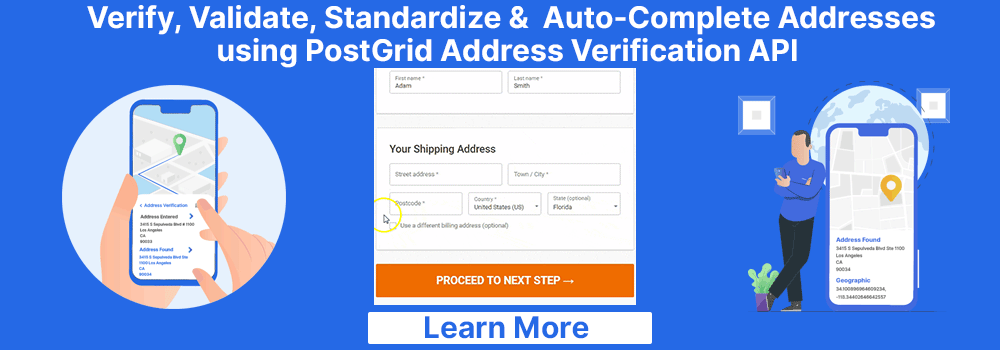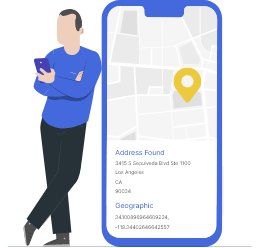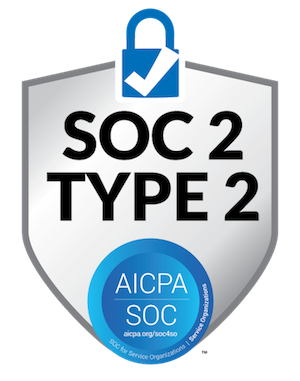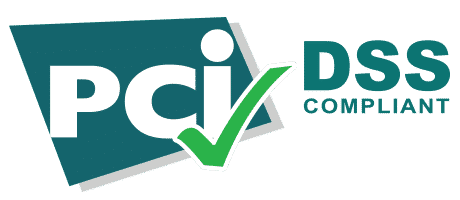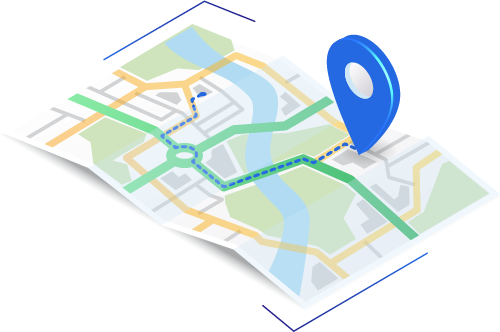
Everything to Know About Korea Post Address Validation
A South Korean notification passed on November 7, 2023, stated that the country has nearly 34,605 ZIP codes and 6,406,401 registered road name addresses with ZIP codes.
Korea Post serves hundreds of thousands of mailing addresses, making delivery route planning as complex as in other countries. Luckily, it offers the Korea Post address validation service for individuals and businesses wanting to mail to South Korea and verify the delivery addresses.
This tool allows users to enter a mailing address and check for validity, accuracy, and completeness. If the address is invalid, the solution helps modify it to make it deliverable. Thus, users can avoid receiving mail returns and dealing with delivery issues and delays.
This blog discusses Korea Post address validation in detail, including how to use it best, its limitations, and more. So, let’s get started!

Key Takeaways
- Korea Post address validation enables you to cross-check your delivery addresses. You can use its Postal Code Search to find postal code information related to your addresses.
- You must write your Korean delivery addresses in the proper format the Korea Post prescribes. Mentioning a US return address on the top left of the envelope or label is recommended to help you get the mailpieces if delivery fails.
- Though helpful, Korea Post address validation has many limitations, such as not providing global verification, geocoding, bulk processing, etc. Businesses wanting a more comprehensive solution should seek an alternative.
- PostGrid’s Address Verification solution allows businesses to reformat and validate addresses against an authoritative database. Thus, you can capture and store accurate and deliverable records across your databases.
What is Korea Post Address Validation?
It is a postal service feature that ensures addresses are correctly formatted and exist within South Korea’s official postal system. This tool helps businesses, government agencies, and logistics providers confirm address accuracy before dispatching mail or packages. The process involves finding a match for an entered address in the Korea Post’s authoritative database. However, it works differently because you cannot enter the whole address and wait for the results. Instead, you can select different address components from a dropdown and get the associated postal codes.
Address validation primarily consists of three steps:
- Autocomplete: This feature gives you a list of suggested addresses when you start typing an address in the address field. Thus, you don’t have to spend time and effort typing the whole thing; instead, you can select the most accurate delivery location from the suggestions.
- Standardization: It can reformat the mailing addresses to match those prescribed by the destination country’s postal guidelines. Thus, the post office doesn’t have trouble sorting mail or reading the addresses and can deliver items on time.
- Verification: Address validation cross-checks whether there is a 100% match for your delivery address in an authoritative system. If yes, it is verified. Otherwise, the address is non-existent/non-registered or has some errors. Fortunately, the earlier steps resolve these mistakes and prepare your records for verification.
How Does Korea Post Address Validation Work?
Korea Post address validation doesn’t offer address autocomplete per se. However, you can still get a list of suggestions from which you can choose different address elements to form the delivery addresses.
Korea Post’s Postal Code Search service lets you get the postal codes associated with your mailing addresses. As shown in the image above, you can navigate to “Road name address” and select elements like the city, road name, etc. Let us see how it works:
- First, click the “Select Special (Metropolitan) City” dropdown. You will see a list of 17 places, including Busan, Daegu, Seoul, etc.
- Then, you can select another subdivision from the metropolitan city you chose, which Koreans refer to as “Si,” “Gun,” or “Gu.”
|
- After selecting this unit, you can move on to the third dropdown, a list of alphabets from A through Z. It indicates the first letter of the road name you want to mail to, like A for Apgujeong-ro, B for Bamgogaeo-ro, or Bongeunsa-ro. Choose the alphabet from which your intended road name starts and move on to the 4th dropdown.
- This dropdown gives you a list of road names starting with your chosen alphabet. For example, if you chose D, you get Dogok-ro and Dosan-daero. Ro stands for “road” (two to seven lanes), and daero represents a “boulevard” (over eight lanes). These road names are further divided into gils, or “streets,” so the address might look like this: Dogok-ro 77-gil, Dogok-ro 78-gil, and so on.
- Then, you can type the building name and the address to which you want to send your letter or package. It is not a dropdown; you must manually type the entire building name to get accurate results. However, you can leave this space blank if unsure of the name.
We tried this tool to look up the address of a famous building in South Korea’s Seoul. Let us find out how it worked:
After selecting the address elements, click “Search” and wait for the results to appear. It gives you a list of addresses to choose from. Sadly, the building name doesn’t appear with the results, so you must know the building number for the building name you typed to match the records.
In this example, the address for Hybe Headquarters is 42 Hangang-daero, Yongsan-gu, Seoul 04389 (the last item on the list in the image shown). When you click on “View,” you get the address in Hangul (Korean), which would be 서울특별시 용산구 한강대로 42 (한강로3가) in this case.
Alternatively, you can click on “Land-Lot number address” to send mail to other areas within the cities and districts. Instead of the road name, you can select the Eup, Myun, or Dong, representing towns, townships, and neighborhoods. These areas use the traditional land-lot numbers instead of the reformed addresses, using road names and building numbers to simplify mailing for non-local businesses and individuals.
Korea Post Address Validation Use Cases
Retail
These businesses rely on fast and accurate shipping to keep customers satisfied. Korea Post address validation helps them verify if a customer’s address exists before sending out orders to prevent delays. It also allows businesses to suggest auto-completed addresses at checkout, simplifying the shopping process for buyers.
Retail and ecommerce stores can offer better delivery options, like same-day shipping and accurate tracking, using verified and standardized mailing addresses. They can also analyze customer locations better and open stores or warehouses in high-demand areas.
Real Estate
Correct addresses are crucial to listing properties accurately and helping clients find homes for real estate companies. Address validation ensures property locations match legal records, making documentation easier for buyers and sellers. Hence, property managers can send tenants rent notices and maintenance updates without confusion.
Realtors can use Korea Post address validation to confirm addresses for open houses, ensuring potential buyers arrive at the right place. Additionally, mortgage lenders and appraisers use verified addresses to process loans and property evaluations smoothly.
Healthcare
Hospitals, clinics, and pharmacies need precise addresses to schedule home visits, deliver medicine, and update patient records. Verified addresses help streamline appointment reminders, reducing missed visits. Pharmacies can use them to confirm prescription deliveries, ensuring patients get the proper medication at the right time.
Health insurance companies use address validation to send policy updates and claim approvals efficiently. Accurate address data helps medical researchers track patient demographics and improve healthcare services in different regions. Healthcare tech companies and other businesses also leverage Korea Post address validation to maintain precise records, deliver marketing mail, and more.
Financial Services
Banks, insurance firms, and credit card companies use address validation to verify customer identities during account sign-ups and transactions. It strengthens security and prevents fraud. Furthermore, it ensures that loan documents, policy updates, and bank statements reach customers promptly.
Verifying addresses facilitates risk assessment by confirming property locations for home loans and insurance coverage. Financial service institutions can also analyze verified addresses to understand customer distribution and open new branches.
Government Agencies
Government offices need verified addresses to manage public records, deliver official documents, and efficiently plan services. Address validation ensures that tax bills, voting materials, and social benefits reach the right people. Emergency response teams use accurate address data to locate households faster, improving public safety.
Census and urban planning departments rely on verified addresses to develop infrastructure, allocate resources, and improve transportation systems. Additionally, law enforcement agencies use correct addresses for investigations and legal notices, ensuring proper communication with citizens.
How Do You Write a South Korean Address for Accurate Deliveries?
Here is an example of a correctly-written and formatted South Korean address:
| Kim Nayoung
National Museum of Korea 137 Seobinggo-ro, Yongsan-gu Seoul 04383 KOR |
Here’s another example of a PO Box address:
| Incheon Central Post Office
229 Inha-ro P.O. Box 25 Nam-gu Incheon 22212 KOR |
As shown above, South Korea’s address format follows a structured layout to maintain uniformity and clarity. A properly formatted address includes:
- Recipient Name: Begin the address by writing the recipient’s full name.
- Building Number and Road Name: The official address format follows the road name system. As discussed above, you can select this address using the Korea Post address validation tool. It looks like this: 42 Hangang-daero.
- District and City Name: It helps identify the location within the region.
- Metropolitan Area or Province: This specifies the broader administrative division, which helps the post office sort envelopes and packages headed to the same locations.
- Postal Code: This address element is a 5-digit code that ensures precise mail sorting and delivery. South Korea recently reformed its postal coding system and recommended using the State Basic District numbers as the postal codes. Earlier, the country used 6-digit codes representing the administrative units (Eup, Myun, and Dong) and other districts allocated to every mail carrier.
- Country (if international): When mailing from abroad, “South Korea” should be added at the end.
When sending something to South Korea or other countries, it is best to write a return address. If the delivery fails, the post office can return your mailpieces. The post office stores items without a return address for a few weeks before discarding them.
You can write your US return address in this format:
| Vanessa Jones
8 SW Main RD Pasadena CA 91104 USA |
Korea Post Address Validation Limitations
Though Korea Post address validation is helpful to many industries, it does not offer many functionalities other address verification solutions offer. Most businesses only use this postal tool to check if they can ship items to their intended delivery location via the post office. Otherwise, they use another courier service.
Here are the primary limitations of Korea Post address validation you must know:
Users Cannot Check International Addresses
The tool only validates addresses within South Korea. If a business or person needs to check an address from another country, they must use a different service. It can cause problems for companies that ship products worldwide or have international audiences. They may need a separate system to confirm overseas addresses, adding extra steps and time to their work. It also means businesses must be careful when handling foreign addresses to avoid shipping mistakes.
No Geocoding Facilities
Korea Post does not provide geocoding, so it cannot show an address’s exact location on a map. It makes it difficult for businesses that need precise location data for deliveries, customer service, or emergency response. Businesses wanting GPS-based services may have to use additional tools to match addresses with map coordinates. Without geocoding, it is also harder to analyze customer locations or plan routes for delivery drivers. Businesses need to use separate mapping software to fill this gap.
The Building Name Does Not Appear With the Search Results
When searching for an address, the Korea Post address validation tool shows only street and building numbers, lacking building names. It can be confusing, especially in areas where notable names help recognize buildings. Many offices, shopping malls, and apartment complexes are popular by their names instead of numbers. Without this information, businesses and delivery services may find it difficult to pinpoint the exact location. Companies seeking a specific building may need additional details from other sources to confirm they have the correct information address.
No Dedicated Software or API
The system does not provide dedicated software or an Application Programming Interface (API) that businesses can integrate into their systems. An API lets companies connect address validation directly to their websites, apps, or databases. Therefore, you must manually check addresses on Korea Post’s website, which takes extra time and effort.
Companies with large amounts of customer data cannot automate the process, making it harder to keep records accurate. Many businesses prefer third-party services offering APIs for faster and smoother address validation.
No Autocomplete Address Functionalities
If you use Korea Post address validation, you do not get the autocomplete feature, so users must enter complete addresses manually. However, many modern websites and apps offer address suggestions while typing, making it faster and easier for users to select the correct address.
People may accidentally enter the wrong details without autocomplete, leading to mistakes. Businesses also experience slower checkout processes in their online stores because customers have to type everything out. Many companies use other address validation solutions, like PostGrid, with autocomplete to improve accuracy and customer experience.
Users Cannot Check Multiple Addresses Simultaneously.
Korea Post address validation only allows users to check one address at a time, which is impractical for businesses that handle large amounts of data. These companies often need to verify hundreds or thousands of addresses in one go. Since Korea Post does not support bulk validation, businesses must check addresses individually, which is slow and inefficient.
Better Alternative to Korea Post Address Validation
Korea Post’s address verification solution works for businesses that occasionally send small-scale mailpieces or want to validate a few addresses. However, companies wishing to do this regularly and in bulk should consider another alternative, like PostGrid’s address verification API. You can integrate it into your CRM, website, or another platform to validate addresses at the entry point or check entire mailing lists within your system.
Korea Post address validation offers limited features because it aims to help people check individual addresses before mailing something via the post office. However, businesses with more complex needs can choose the alternative.
PostGrid offers all-in-one solutions for parsing, standardizing, and verifying delivery addresses. You can upload mailing lists containing hundreds of thousands or check a single address. PostGrid is highly flexible and offers its solutions at affordable prices.
Korea Post vs PostGrid Address Validation
| Parameters | Korea Post Address Validation | PostGrid Address Validation |
| Purpose | It allows businesses and individuals to check addresses in South Korea for shipping purposes. | PostGrid lets businesses standardize and verify delivery addresses for data management, mailing, marketing, etc. |
| Coverage | Korea Post address validation covers addresses exclusively in South Korea. | PostGrid offers address verification for 250+ countries and territories. |
| Standardization | This tool formats your mailing addresses according to Korean postal standards. | It standardizes addresses based on the destination country’s postal regulations. |
| Bulk Address Checking | Korea Post address validation cannot check multiple addresses at a time. | PostGrid allows batch processing of large volumes of addresses globally. |
| API Integration | You can only cross-check delivery addresses using the postal website. | It offers RESTful APIs to integrate with different CRM, ERP, and ecommerce platforms. |
| Autocomplete | Users can use dropdown menus on the Postal Code Search tool, but there’s no explicit autocomplete function. | PostGrid supports address auto-completion in multiple languages. You can integrate the API into your shopping and other platforms. |
| Geocoding and Reverse Geocoding | It does not provide these features with its address validation tool. | PostGrid offers geocoding and reverse geocoding for Korean and international addresses. |
| Pricing | You can check individual mailing addresses for free but don’t get other features, such as global checking and parsing. | It verifies, standardizes, and geocodes all national and international addresses at reasonable prices. |
More About PostGrid’s Address Verification API
PostGrid offers advanced, real-time address validation for businesses that want access to deliverable, accurate, and updated customer addresses. Companies can use this location data for anything, from fulfilling orders and sending bills to marketing and making expansion plans.
PostGrid complies with local and national data protection laws, allowing you to stay compliant and avoid penalties. Plus, you have ready-to-use data across your systems, complementing your operations in different departments, like sales, promotions, logistics, finance, etc. Sign up to start using our Address Verification API or dashboard now!

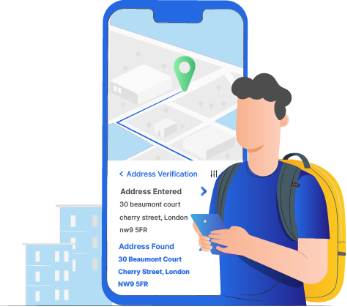

 Also Read:
Also Read: 